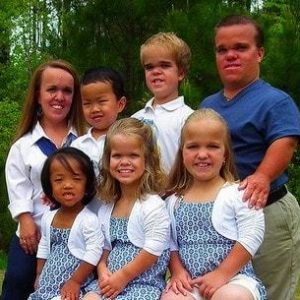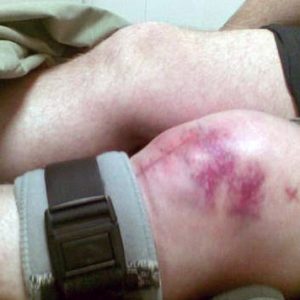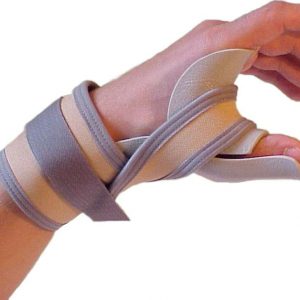Achondroplasia is a congenital disorder in which breaks down the process of bone growth. Mainly affects the bones of the skeleton and skull base.
The cause of achondroplasia is known reliably is a mutation of the gene FGFR3.
It is revealed that 20% of clinical cases, the abnormality is inherited, the other 80% it occurs in the background of a mutation arising for the first time.
The statistics could be different, but the proportion of children with achondroplasia die in the stage of fetal development.
Pathology has other names – is a congenital chondrodystrophy, disease Parro-Marie, diaphyseal aplasia.
General data
Achondroplasia is a disorder in which the newborn child has disproportion – short limbs, but normal body length.
Adult patients with achondroplasia have characteristic features is:
- low height (130 cm or less);
- curved in the posterior-anterior direction of the spine;
- specific saddle nose;
- large head with projecting frontal humps.
Female patients are affected more often than men.

The manner in which it would be possible radically to cure chondropathy, at the moment not developed to restore growth and body proportions are not yet possible. But the treatment is carried out, it aims to reduce the negative consequences of the disease and prevent its complications.
Causes and development of disease
The cause of achondroplasia studied well is a failure in the bone development, which occurs because of degeneration (hypoplasia) epiphyseal cartilage (they are located at the ends of tubular bones). In turn, the underdevelopment of the cartilage occurs due to genetic disorders.

The problem is that because of genetic failure, the cells of the growing zone of cartilage (because of it is bone growth) are not orderly, but chaotic. Because of this disrupted the normal process of ossification, which grow in the bone structure. Due to such changes, the growth and development of bones are broken.
Note that if achondroplasia such pathological processes relate solely to bone elements that grow on the so-called encontrarnos type (development of cartilage and its subsequent ossification).
In the first place is:
- tubular bones (femur, tibia, humerus, etc.);
- bones of the skull base.
The disparity evolves from the fact that the other bones continue to grow and develop normally. So, the bones of the cranial vault, the elements of which grow from the connective tissue, do not depend on pathological processes developing in the epiphyseal bones.
Thus they are laid is:
- provokes imbalances (mismatch of dimensions) between the head and the body;
- causes changes the shape of the skull as a whole, as the bones of the cranial vault are normal, and the bones of its Foundation develop properly.
As it is a genetically caused disease, it can cause any factors that can trigger mutations. This means that any pathogenic effect on a woman’s body during pregnancy can lead to abnormalities in the development of the unborn child.

The main factors that increase the risk of achondroplasia are those that have a negative impact on the body of the pregnant woman and consequently fetal development.
This:
- violation of the principles of healthy nutrition of the future mother – failure to follow the diet, inadequate intake of fats, proteins, carbohydrates, mineral substances, regular consumption of junk food (fast food, hard to digest food);
- bad habits – Smoking, alcohol and drugs;
- sharp fluctuations in temperature – from cold to overheating;
- chronic stress;
- injuries to the abdomen. This can be trauma of domestic, industrial, as well as during accidents (e.g. road accidents);
- the radiation exposure;
- the medication for other purposes and without medical supervision;
- low physical activity – ignoring the basic exercise;
- chronic lack of sleep;
- fatigue.
It should be remembered that such violations of a healthy lifestyle can impact negatively on a woman’s body before she gets pregnant. Even if a woman is planning offspring, changed the lifestyle, but used to ignore a healthy lifestyle, the risk of having a child with disabilities (in this case achondroplasia) is still available.
Symptoms of achondroplasia
Achondroplasia is diagnosed at an early age by the appearance of the patient. But as the child grows and develops, violations of the diseased structures can also change. In addition, there may be violations of other organs and tissues.
Symptoms at birth
At birth there is a violation of the anatomical proportions of the child – his:
- relatively large head;
- short handle;
- short legs (this feature stands out).
It is noted also characterized by the structure of the head:
- forehead convex, projecting forward. Sometimes it has the same appearance as the front hangs over the skull;
- the cerebral part of the skull is increased;
- bulging occipital and parietal tuber.
Due to the fact that it was broken the bone development of the skull base, develop disorders of the facial skull – namely:
- eyeballs these patients, widely spaced, are located deep in the eye sockets (the paired openings of the skull);
- near the inner corner of the eye has a specific additional fold;
- the nose has a distinctive saddle shape – it is tapered, the upper part wider than normal;
- the frontal bone is markedly bent forward, such changes are symmetrical;
- the upper jaw can significantly protrude above the bottom;
- the language is rough (I think swollen);
- hard and soft palate are higher than normal.
Some children with achondroplasia may develop hydrocephalus is a disruption of the normal proportions of the skull due to the increased amount of cerebrospinal fluid in the ventricular system of the brain.
Revealing are changes in the upper and lower limbs in patients with achondroplasia:
- hands and feet uniformly shortened, thus often suffers from the length of the hips and shoulders. The child’s hands can only reach to the navel;
- almost all the segments of the upper and lower extremities in more or less curved;
- foot wide (like “trampled”) and short;
- the palm is broad, II-V fingers are shortened, while almost the same length, at the same time I finger is longer than the other.

Notable is the trait observed in the first months of life – these children are on the hands and feet visible fat protrusions (pads) and in skin folds.
The trunk when it is developed in the normal range, the chest is also not changed. Belly protruding in the back-front direction, and the pelvis is rejected in the front-rear direction due to these changes it seems that the buttocks are stronger than normal.
Newborns diagnosed with achondroplasia more often than in healthy children of the same age, sudden death during sleep. The reason is the critical compression of the medulla oblongata and the upper fragment of the spinal cord in the narrow cervical opening.
Often there are violations of the breath, which are due to such reasons as:
- features of the structure of the facial skull (can be flattened nasal bone that obstructs the flow of air into the upper respiratory tract and from there into the lungs through the bronchi);
- increased in comparison with normal tonsils (with their tissue structure is within the normal range);
- small chest – its excursion (movement during inspiration and exhalation) does not ensure receipt of a normal amount of air into the lungs, necessary for oxygen supply of organs and tissues.
Symptoms in the 1-2 year of life
As the child grows and develops, his background of achondroplasia arise other disorders.

The child diagnosed with achondroplasia disturbed the tone of the muscle patterns. For this reason, they are not able to hold in normal position the spine. The result is a cervical-thoracic kyphosis – an abnormal bending, which manifests itself in the form of an arc, deflected forward. A distinctive feature of this bend – it disappears after the child begins to walk.
Almost all children with achondroplasia are different some lag in physical development:
- unable to hold his head only to 3-4 months of life;
- begin to sit in 8-9 months or even later;
- learn to walk 1.5-2 years.
At the same time, these children’s intellectual development does not suffer that mental disorders do not develop. Such features should be considered in the differential (distinctive) diagnosis of achondroplasia with other pathologies that manifestirutaya violation of the physical and mental development.
Symptoms as they grow older
1-2 years after the birth of a child changes in the bones are aggravated. This happens because as they grow older observed a perversion of the epiphyseal bone growth, although periosteal growth remains normal.

Occur in the following pathological signs:
- bones become thicker and lumpy;
- develops their pathological bending;
- the elasticity of the epiphyseal (end) and metaphyseal (adjacent to the epiphyseal) departments of tubular bones remains elevated, so the bone can bend. Because this form of valgus and varus deformity of the limbs and feet are similar respectively to the letters “O” and “X”. This pathological condition progresses rapidly with early inadequate load. The reason is reinforced pull of the muscles that are well developed;
- due to the fact that patients with achondroplasia interferes with the normal axis of the limb, they also develop a curvature of the foot and knee joints become loose like.
Particularly pronounced changes are observed from the side of the lower limbs:
- the femur, are bent and in the lower divisions literally twist the outside to the inside;
- because of the uneven growth of leg bones fibula like “extends” up in my upper division, from a-z and interrupting its connection with the tibia. Because of this plug is off angle of the ankle joint, the joint itself takes place, the foot is an unnatural position.
The upper limb can also be bent is especially pronounced process of distortion occurs in the forearm.
Symptoms in adults
Adult patients who suffer from achondroplasia, the first thing that catches the eye deficiency of growth – it occurs due to shortening of the lower extremities. The average height of women is equal to 124 cm, males – 130 cm
Shortening of the upper extremities is preserved. Adult patients with the described pathology the fingers reach the groin.
Changes in the head and facial skeleton continues, in some patients they become more pronounced. Signs the following:
- more enlarged and protruding brain region of the skull;
- protruding forehead, which is hanging over the facial skull;
- deep nose;
- malocclusion, which can be seen even without special inspection.
These patients develop abnormalities of other organs and systems. Most often observed:
- strabismus – deviation of one or both eyes alternately looking directly;
- the tendency to obesity is increase of body weight due to the delaying of fat;
- narrowing of the nasal passages;
- obstruction (obstruction) of the upper respiratory tract.
Separately allocate such a significant demonstration of how a narrowing of the spinal canal. Most often, this pathological condition develops in the lumbar spine, rarely in the cervical or thoracic.
Narrowing of the spinal canal is manifested neurological symptoms – most often it is:
- loss of sensitivity
- paresthesia in the legs – perverted sensation (“pins and needles”, tingling, and so on);
- pain in the legs.
Also you may experience the following neurological signs:
- dysfunction of the pelvic organs of urination, discharge of fecal matter;
- paresis – impaired motor activity;
- paralysis – complete absence of motor activity
and several others.
Diagnosis
Since the patient has a characteristic appearance (in particular, the proportions of the body) and a smaller-than-normal growth, the diagnosis is not difficult under his inspection.
At the birth of such a child in a special table enter his anthropometric parameters. The table must complement the growth of the little patient. In doing so, a comparison with normal values to assess the degree of development of achondroplasia.
The most informative method of diagnosis in achondroplasia is an x-ray.

When radiography of the skull in these patients are the following symptoms:
- the disparity between face and brain part;
- reduction of the occipital hole;
- the increase of the lower jaw and skull bones;
- the change of Turkish saddle – it becomes like a Shoe, its base is at the same time – flat and long.
Data radiography of the chest often do not deviate from the norm. A number of patients possible following deviations:
- the sternum is slightly curved and projecting forward;
- ribs thickened;
- observed deformation of the ribs in the place where they go in the cartilage of the arc;
- may be absent normal anatomical curves of the collarbone – these bones are flat.
When radiography of the spine marked changes are often not observed. May include the following:
- physiological curves (particularly in the cervical spine) is expressed more weakly than in healthy people;
- may be lumbar hyperlordosis – excessive curvature of the spine with the convexity forward.
When radiography of the pelvis is determined by the following:
- the iliac wings have a rectangular shape, they are deployed and somewhat shorter;
- acetabulum (the one with which is formed the hip joint) is located horizontally.
Informative is x-ray bones – is determined by the following:
- shortening and thinning of the diaphysis (the Central division of the bones);
- thickening and enlargement metafit – they take the shape of the glass;
- the final sections of bones are immersed in metaphysi-type hinges.
Radiography of the joints helps to detect these changes:
- the articular surfaces of the deformed and incongruent (not matching with each other);
- the articular slits expanded;
- the shape of the end sections of bones broken.
When x-rays of the knee noted that fibula are elongated.
When x-rays of the ankle joint defines the rotation and displacement of the foot inside.
Other survey methods involved if necessary. This:
Also required consultation related professionals:
- neurosurgeon – to exclude hydrocephalus;
- otolaryngologist – to determine the condition of the nasal passages;
- respiratory therapist – to assess the patency of the upper airway.
Laboratory methods of examination are not informative.
Differential diagnosis of
Differential diagnosis there are practically no requirements to spend because of the presence of the described pathology clearly indicate a decrease in the growth of the patient, the violation of proportions between the individual parts of the head, shortening of the limbs.

Complications
Complications that can accompany achondroplasia, it is most often:
The first two complications are due to narrowing of the nasal passages that occurs in achondroplasia, and the third due to an obstruction (blockage) of the upper respiratory tract.
Treatment
Complete recovery of patients diagnosed with achondroplasia on the basis of achievements of modern Orthopaedics impossible. Attempts were made to influence the “flawed” areas of bone growth with growth hormone, but positive results are not yet announced.
In early childhood it is necessary to conduct a treatment that strengthens the muscles and prevents deformation of the limbs (at least, reduce its severity).
The basis of treatment – the following nominations:
- complex LCF under the supervision of a physical therapist;
- massage;
- wearing special orthopedic shoes;
- regulation of nutrition to prevent obesity, fraught with a heavy load on modified limbs.
Surgical treatment of achondroplasia also is testimony to it are:
- expressed deformation of the limbs, which worsen the quality of life;
- narrowing of the spinal canal.
Performs the following operations:
- osteotomy (excision of the “extra” bone fragments) – correction of deformities;
- laminectomy to remove spinal stenosis.
Please note:
If achondroplasia is practiced surgery to increase your height through elongation of the limbs. These operations are carried out in two stages – first, lengthen the thigh with one hand and drumstick with the other, after a while the same manipulation performed on the other thigh and lower leg.
Prevention
Specific prevention does not exist. The risk of this disease can be reduced if to provide normal conditions of pregnancy and, therefore, the development of the fetus.

This:
- compliance with the principles of healthy eating pregnant – compliance with diet, balanced diet, avoiding harmful food;
- response to changes in temperature – avoiding hypothermia and overheating;
- avoiding situations that cause stress;
- the avoidance of trauma of the abdomen;
- avoiding contact with sources of radiation;
- the medication strictly according to prescription;
- physical exercise, sufficient physical activity;
- ensuring sound sleep for sufficient amount of time;
- avoidance of overwork, both physical and mental;
- the categorical prohibition of any bad habits – Smoking, drinking alcoholic beverages and drugs.
Forecast
The prognosis of achondroplasia complicated. These patients adapt to the misconduct of their skeleton, socializers even employed. But quality of life may suffer.




Very helpful! Is there anything more I should know next? Or is this okay?
NEVER stop trying. Onward!
Hey, I just found your blog and I like this post a whole lot. You put forward some thought-provoking points. Where may I learn more?
So, I just found your blog and I resonated with this entry particularly. . How can I read more?
What抯 Happening i am new to this, I stumbled upon this I have found It absolutely useful and it has aided me out loads. I hope to contribute & assist other users like its helped me. Great job.
Excellent beat ! I wish to apprentice even as you amend your site, how can i subscribe for a weblog web site? The account aided me a appropriate deal. I were tiny bit familiar of this your broadcast provided brilliant transparent idea